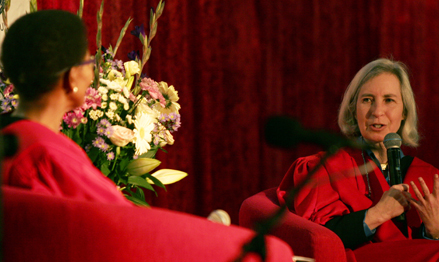“To forgive is not an obligation. It’s a choice.” – Prof Minow during Reconciliation Lecture
|

“To forgive is not an obligation. It’s a choice.” – Prof Minow during the Third Annual Reconciliation Lecture entitled Forgiveness, Law and Justice.
Photo: Johan Roux |
No one could have anticipated the atmosphere in which Prof Martha Minow would visit the Bloemfontein Campus. And no one could have predicted how apt the timing of her message would be. As this formidable Dean of Harvard University’s Law School stepped behind the podium, a latent tension edged through the crowded audience.
“The issue of getting along after conflict is urgent.”
With these few words, Prof Minow exposed the essence of not only her lecture, but also the central concern of the entire university community.
As an expert on issues surrounding racial justice, Prof Minow has worked across the globe in post-conflict societies. How can we prevent atrocities from happening? she asked. Her answer was an honest, “I don’t know.” What she is certain of, on the other hand, is that the usual practice of either silence or retribution does not work. “I think that silence produces rage – understandably – and retribution produces the cycle of violence. Rather than ignoring what happens, rather than retribution, it would be good to reach for something more.” This is where reconciliation comes in.
Prof Minow put forward the idea that forgiveness should accompany reconciliation efforts. She defined forgiveness as a conscious, deliberate decision to forego rightful grounds of resentment towards those who have committed a wrong. “To forgive then, in this definition, is not an obligation. It’s a choice. And it’s held by the one who was harmed,” she explained.
Letting go of resentment cannot be forced – not even by the law. What the law can do, though, is either to encourage or discourage forgiveness. Prof Minow showed how the law can construct adversarial processes that render forgiveness less likely, when indeed its intention was the opposite. “Or, law can give people chances to meet together in spaces where they may apologise and they may forgive,” she continued. This point introduced some surprising revelations about our Truth and Reconciliation Commission (TRC).
Indeed, studies do report ambivalence, disappointment and mixed views about the TRC. Whatever our views are on its success, Prof Minow reported that people across the world wonder how South African did it. “It may not work entirely inside the country; outside the country it’s had a huge effect. It’s a touchstone for transitional justice.”
The TRC “seems to have coincided with, and maybe contributed to, the relatively peaceful political transition to democracy that is, frankly, an absolute miracle.” What came as a surprise to many is this: the fact that the TRC has affected transitional justice efforts in forty jurisdictions, including Rwanda, Sierra Leone, Cambodia and Liberia. It has even inspired the creation of a TRC in Greensborough, North Carolina, in the United States.
There are no blueprints for solving conflict, though. “But the possibility of something other than criminal trials, something other than war, something other than silence – that’s why the TRC, I think, has been such an exemplar to the world,” she commended.
Court decision cannot rebuild a society, though. Only individuals can forgive. Only individuals can start with purposeful, daily decisions to forgive and forge a common future. Forgiveness is rather like kindness, she suggested. It’s a resource without limits. It’s not scarce like water or money. It’s within our reach. But if it’s forced, it’s not forgiveness.
“It is good,” Prof Minow warned, “to be cautious about the use of law to deliberately shape or manipulate the feelings of any individual. But it is no less important to admit that law does affect human beings, not just in its results, but in its process.” And then we must take responsibility for how we use that law.
“A government can judge, but only people can forgive.” As Prof Minow’s words lingered, the air suddenly seemed a bit more buoyant.